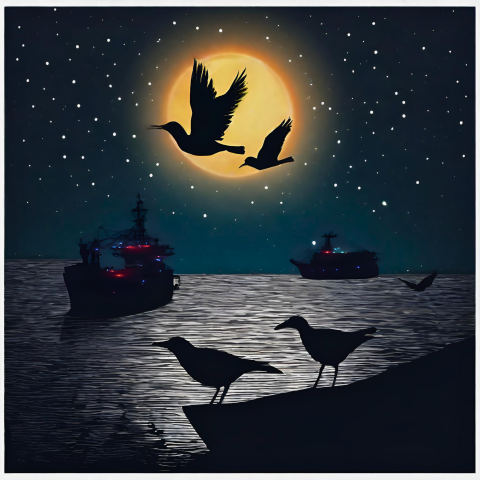About this Collection
Billions of birds navigate at night using stars and moonlight, especially during fall and spring migrations. Artificial lighting, especially at sea, disorients birds, leading to exhaustion and collisions that often result in death or injury. Seabirds, who live at sea for most of their lives, are especially vulnerable. Nights with low visibility, including periods of fog, new moon nights, or bad weather, often result in "bird storms" where hundreds of birds are impacted at once, causing significant death and injury. Collisions are not only devastating to birds but can also damage vessels, increase maintenance costs, and pose a safety risk for people on board. This has become a global issue. The good news: collisions are preventable!
Do you work with offshore vessels or other structures with lights at night?
Here is how you can help!
- Limit Light Use: Only use lights when necessary for safety, operations and navigation
- Choose Smart Controls: Use automatic timers, dimmers, or motion sensors to turn lights on and off
- Use Focused Lighting: Shield light down, facing the deck to reduce spillover into the sky and water
- Prevent Light Spill: Use blackout curtains or blinds in windows at night
Choose the Right Lights
- Dimmable lights with lowest possible intensity to satisfy safety requirements
- Correlated Color Temperature (CCT) at or below 2200K (yellow to amber)
- Motion sensor lights with passive infrared (PIR) detectors
Be Extra Careful During:
- Peak bird migration seasons: April-May and August-October
- Seabird fledging (when baby birds leave the nest) in September-December
- Foggy, rainy and low cloud nights
- Dark moon phases
Benefits Beyond the Birds
- Biodiversity Conservation: Protecting birds maintains the balance of marine and coastal ecosystems
- Energy Savings: Smart controls reduce energy use, resulting in cost savings and a lower carbon footprint
- Reduced Maintenance: Less structural damage = less maintenance + more time and energy for staff
- Safety Enhanced: Reducing glare minimizes hazards, especially on wet decks and during emergencies
- Improved Human Health: Natural, dimmer lighting results in better sleep and well-being for passengers
- Education Opportunity: Engage with passengers to raise awareness about marine conservation topics
- Enhanced Experiences: Everyone likes clearer, starry skies; no one wants to witness a tragic collision
- Improved Reputation: Taking sustainable, eco-friendly actions can create a more positive public image
Additional Resources
- Printable guide for Bird-Conscious Lighting for Vessels & Offshore Structures best practices (see below).
- Check BirdCast to know when birds migrate near coasts.
- Learn about the “Lights Out” programs and Urban Bird Treaty Cities around the country.
- Visit DesignLights Consortium and International Dark Sky Association for more on how you can reduce light pollution.
Read more about the issue of nighttime lighting

